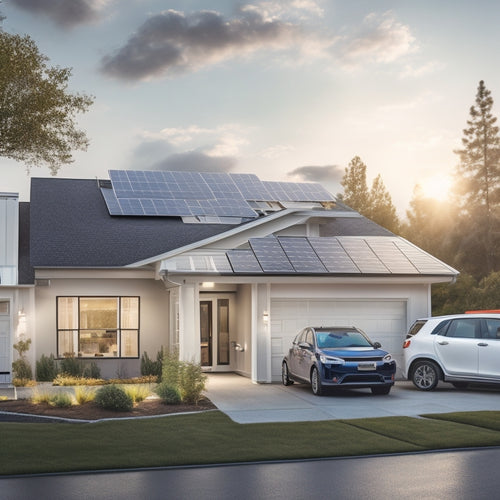Organizing With Solar: Powering Your Classroom the Eco-Friendly Way
Share
You're about to transform your classroom into an eco-friendly hub, powered by the sun! Start by evaluating your energy needs, identifying devices that consume the most energy, and creating a power map to visualize energy usage. Then, choose high-efficiency solar panels, design a sustainable classroom layout, and integrate solar energy concepts into your curriculum. You'll not only reduce your carbon footprint but also inspire a new generation of environmentally conscious students. As you set out on this journey, discover more innovative strategies to maximize energy efficiency, measure the impact of solar energy, and overcome common implementation challenges.
Key Takeaways
• Assess energy needs by identifying devices that consume the most energy and tracking daily usage patterns to create a power map for improvement.
• Engage teachers early on in planning and decision-making stages to build confidence and enthusiasm for solar energy integration.
• Choose high-efficiency solar panels (15%-22%) for maximum energy production, considering panel quality control and type of photovoltaic cells used.
• Integrate solar energy concepts into the curriculum, making it a core part of education, and fostering solar literacy in students to promote environmental stewardship.
• Track key performance indicators, such as kilowatt-hours generated and carbon footprint reduction, to measure the impact of solar energy and inspire students to take an active role in monitoring and improving the system.
Assessing Your Classroom's Energy Needs
To effectively organize with solar power, you'll first need to assess your classroom's energy needs, identifying which devices and appliances consume the most energy and how often they're used daily.
This essential step helps you understand your energy usage patterns, allowing you to make informed decisions about your solar power system.
Conducting an energy audit is a great way to start.
This involves tracking your energy usage over a specific period, usually a week or a month, to identify areas of high energy consumption.
You can use a power meter or a Kill A Watt meter to measure the energy usage of individual devices.
Create a power map to visualize your energy usage and identify opportunities for improvement.
Choosing the Right Solar Panels
As you start selecting the perfect solar panels for your classroom, you'll want to weigh a few key factors.
You'll need to assess the panel's efficiency, comparing how much energy it can produce per hour of sunlight.
Assessing Panel Efficiency
To maximize your solar panel investment, select panels with high efficiency ratings, which substantially impact the amount of energy your system produces. Efficiency ratings vary between 15% to 22%, with higher ratings indicating more energy harvested per hour of sunlight.
When evaluating panel efficiency, consider the type of photovoltaic (PV) cells used. Monocrystalline silicon cells, for instance, are more efficient than polycrystalline cells. Look for panels with a high power output per unit area, measured in watts per square foot. A higher power density means more energy generated in a smaller space.
To guarantee you're getting high-quality panels, prioritize Panel Quality Control. Reputable manufacturers implement rigorous testing and inspection processes to verify superior performance.
Additionally, consider the energy harvesting capabilities of your panels. A more efficient panel will capture more sunlight and convert it into usable energy, reducing your reliance on the grid. By choosing efficient solar panels, you'll be well on your way to powering your classroom the eco-friendly way.
Comparing Panel Durability
When shopping for solar panels, dig deep into the durability of each model, as a longer-lasting panel will save you time, money, and hassle in the long run. You want to verify your panels can withstand the elements and keep performing well for years to come.
To do this, look for panels with excellent weather resistance. This means they can handle harsh weather conditions like heavy rain, hail, and extreme temperatures.
Material science plays a vital role in a panel's durability. Look for panels made with high-quality materials that can resist corrosion and degradation.
Check the warranty offered by the manufacturer, as a longer warranty period often indicates a more durable product. Additionally, research the manufacturer's reputation and read reviews from other customers to get a sense of how well their panels hold up over time.
Evaluating Cost Effectiveness
Your budget is a critical factor in choosing the right solar panels, so you must weigh the upfront cost against the long-term savings and benefits. Evaluating cost effectiveness is vital to guarantee that your solar panel investment pays off in the long run.
To make an informed decision, consider the following key factors:
-
Budget Flexibility: Determine how much you're willing to spend on solar panels and balance it with the benefits you expect to gain.
-
Cost Comparison: Research and compare prices of different solar panel brands and models to find the best value for your money.
-
Energy Efficiency: Assess the energy output of each panel and calculate how much you'll save on your energy bills.
- Warranty and Maintenance: Factor in the cost of maintenance and repairs, as well as the warranty period offered by the manufacturer.
Designing a Sustainable Classroom Layout
As you set out to design a sustainable classroom layout, you'll want to create an eco-friendly zone that promotes learning and minimizes waste.
By strategically placing furniture and incorporating green learning hubs, you'll be able to optimize the space for collaboration and creativity.
Eco-Friendly Zone Creation
Designing a sustainable classroom layout begins with identifying the three essential eco-friendly zones that will transform your learning space into a thriving hub of environmental awareness. By creating these zones, you'll not only reduce your classroom's carbon footprint but also foster a sense of community and responsibility among your students.
The three essential eco-friendly zones to include in your sustainable classroom layout are:
The Nature Nook: A cozy reading area with eco-friendly decor, such as reclaimed wood shelves and sustainable textiles, that encourages students to connect with nature.
The Innovation Station: A collaborative workspace equipped with solar-powered tools and recycled materials that inspires students to think creatively about sustainability.
The Wellness Hub: A calming area with plants and natural light that promotes student well-being and mindfulness.
The Eco-Exploration Zone: An interactive area featuring educational resources and hands-on activities that teach students about renewable energy and environmental conservation.
Optimal Furniture Placement
By strategically placing furniture in your sustainable classroom, you'll create a functional and eco-friendly space that encourages collaboration, creativity, and a deeper connection with the natural world.
A well-designed layout can boost student engagement, improve focus, and reduce distractions. To achieve this, consider incorporating flexible workspaces that can be easily rearranged to accommodate different learning activities.
This might include modular desks, comfortable seating areas, and writable walls that foster collaboration and creativity.
When arranging your furniture, prioritize an ergonomic layout that promotes comfort and reduces eye strain.
Position computers and other digital tools to minimize glare, and facilitate good posture by placing chairs and desks at comfortable heights.
By doing so, you'll create a space that not only supports the well-being of your students but also inspires a sense of community and belonging.
Green Learning Hubs
Your green learning hub takes shape as you strategically cluster furniture into zones that foster collaboration, creativity, and a deep connection with the natural world. This thoughtful approach to sustainable architecture creates an eco-classroom culture that inspires students to thrive.
-
Nature-inspired zones: Designate areas that mirror the natural world, such as a 'forest' for reading or a 'meadow' for group work.
-
Flexible seating: Incorporate multipurpose furniture that encourages movement and collaboration, like bean bags or modular sofas.
-
Living walls: Integrate plants into your design to purify the air and create a calming atmosphere.
- Eco-friendly materials: Choose sustainable materials for furniture and decor, such as reclaimed wood or recycled plastic.
Integrating Solar Into Your Curriculum
As you prepare to integrate solar into your curriculum, start by identifying the learning objectives and standards you want to address, and then explore how solar energy can be used to illustrate complex concepts in a real-world context.
This is your chance to foster Solar Literacy in your students, empowering them to become Renewable Minds who understand the importance of sustainable energy.
By incorporating solar energy into your lesson plans, you'll not only meet educational standards but also inspire a new generation of eco-conscious leaders.
Begin by introducing basic solar concepts, such as the science behind photovoltaic cells and how they generate electricity.
Then, explore further into real-world applications, like how solar power can reduce carbon emissions and mitigate climate change.
You can also examine the economic benefits of solar energy, like job creation and cost savings.
By making solar energy a core part of your curriculum, you'll cultivate a sense of responsibility and environmental stewardship in your students.
Maximizing Energy Efficiency Strategies
You're now ready to supercharge your solar-powered curriculum by exploring innovative strategies to maximize energy efficiency, empowering your students to become masters of sustainable energy management.
To take your energy efficiency to the next level, consider these essential strategies:
-
Conduct Energy Audits: Identify areas of energy waste and opportunities for improvement in your classroom or school.
-
Implement Behavioral Changes: Encourage students to develop habits like turning off lights and electronics when not in use, and using natural light when possible.
-
Optimize Your Lighting: Replace traditional light bulbs with energy-efficient LED or CFL bulbs, and consider installing occupancy sensors to automate lighting control.
- Involve Your Students: Encourage students to take ownership of energy management by creating a 'Green Team' to monitor and reduce energy consumption.
Measuring the Impact of Solar Energy
By tracking key performance indicators, such as kilowatt-hours generated and carbon emissions reduced, you can quantify the environmental impact of your solar energy system and inspire your students to take an active role in monitoring and improving its performance.
To get started, let's explore some essential energy metrics to track:
| Metric | Why it Matters |
|---|---|
| Kilowatt-hours (kWh) generated | Measures the total energy produced by your solar panels |
| Carbon footprint reduction | Calculates the amount of CO2 emissions avoided by using solar energy |
| Energy savings | Compares the cost of solar energy to traditional energy sources |
| Peak sun hours | Tracks the amount of solar energy available at your location |
Overcoming Common Implementation Challenges
Implementing a solar energy system can be a complex process, and you'll likely encounter some common challenges that can slow down or even derail your project.
Lack of Teacher Buy-in
Engage your teachers early on in the process and involve them in the planning and decision-making stages. This will help build their confidence and enthusiasm for the project.
Insufficient Funding
Explore alternative funding options, such as grants, crowdfunding, or corporate sponsorships. You can also consider partnering with local organizations or businesses to secure funding.
Community Resistance
Conduct community outreach and education efforts to address concerns and misconceptions about solar energy. This can include hosting public meetings, creating informational materials, and engaging with local media.
Technical Issues
Work with experienced installers and engineers to facilitate a smooth installation process. Regularly inspect and maintain your system to prevent technical issues down the line and guarantee a trouble-free operation.
Solar Energy Storage and Backup
With a solar energy system in place, guaranteeing a reliable and efficient supply of power during periods of low sunlight or grid outages requires integrating energy storage and backup solutions, which is vital for making this happen.
You'll want to think about a battery bank that stores excess energy generated during the day for use during the night or on cloudy days.
Proper battery maintenance is essential to maintain the longevity and performance of your energy storage system. Regularly check the battery's state of charge, voltage, and temperature to prevent overheating or overcharging.
Having a backup plan in place will give you grid independence, allowing your classroom to stay powered even when the grid goes down.
Imagine the confidence and sense of security that comes with knowing your solar energy system has got you covered, no matter what.
With energy storage and backup solutions, you'll be well on your way to creating a sustainable and resilient learning environment that's powered by the sun.
Frequently Asked Questions
Can I Install Solar Panels on a Rented Classroom Building?
You'll need to check your rental agreement for any restrictions, and don't forget to get your landlord's approval before installing solar panels on your rented classroom building - it's essential to get their buy-in!
How Do I Ensure Student Safety Around Solar Equipment?
As you integrate solar equipment into your learning space, you'll want to guarantee student safety by minimizing electrical hazards through proper installation and supervision strategies, like designating a 'solar team' to monitor and maintain the equipment.
Are There Any Government Incentives for Classroom Solar Projects?
You'll be thrilled to know that yes, there are government incentives for classroom solar projects! You can explore Federal Grants and Tax Credits to help fund your eco-friendly initiative, making it more accessible and affordable for your school.
Can Solar Energy Power My Classroom's Heating and Cooling?
You can absolutely harness solar energy to power your classroom's heating and cooling! By optimizing energy efficiency, you'll achieve thermal comfort while reducing your carbon footprint - creating a cozy, eco-friendly learning space that's perfect for your students!
How Often Should I Clean My Solar Panels for Optimal Performance?
You'll want to clean your solar panels regularly to prevent dust accumulation, which can reduce panel efficiency by up to 25%! Aim to clean them every 6-12 months, or more often if you're in a dusty area.
Related Posts
-

What Electric Vehicle Owners Need for Home Energy
As an electric vehicle owner, you need to optimize your home energy system to guarantee efficient, sustainable, and c...
-

What Makes a Road Bike-Friendly by Design?
As you plan and design roads, incorporating features like dedicated bike lanes, smooth surfaces, and traffic calming ...
-

Planning for an Electric Vehicle-Friendly Urban Future
As you plan for an electric vehicle-friendly urban future, you'll need to integrate high-power charging stations, sma...


